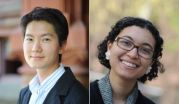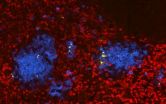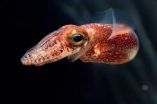(Press-News.org) LA JOLLA, CA—May 15, 2014—Mice crippled by an autoimmune disease similar to multiple sclerosis (MS) regained the ability to walk and run after a team of researchers led by scientists at The Scripps Research Institute (TSRI), University of Utah and University of California (UC), Irvine implanted human stem cells into their injured spinal cords.
Remarkably, the mice recovered even after their bodies rejected the human stem cells. "When we implanted the human cells into mice that were paralyzed, they got up and started walking a couple of weeks later, and they completely recovered over the next several months," said study co-leader Jeanne Loring, a professor of developmental neurobiology at TSRI.
Thomas Lane, an immunologist at the University of Utah who co-led the study with Loring, said he had never seen anything like it. "We've been studying mouse stem cells for a long time, but we never saw the clinical improvement that occurred with the human cells that Dr. Loring's lab provided," said Lane, who began the study at UC Irvine.
The mice's dramatic recovery, which is reported online ahead of print by the journal Stem Cell Reports, could lead to new ways to treat multiple sclerosis in humans.
"This is a great step forward in the development of new therapies for stopping disease progression and promoting repair for MS patients," said co-author Craig Walsh, a UC Irvine immunologist.
Stem Cell Therapy for MS
MS is an autoimmune disease of the brain and spinal cord that affects more than a half-million people in North America and Europe, and more than two million worldwide. In MS, immune cells known as T cells invade the upper spinal cord and brain, causing inflammation and ultimately the loss of an insulating coating on nerve fibers called myelin. Affected nerve fibers lose their ability to transmit electrical signals efficiently, and this can eventually lead to symptoms such as limb weakness, numbness and tingling, fatigue, vision problems, slurred speech, memory difficulties and depression.
Current therapies, such as interferon beta, aim to suppress the immune attack that strips the myelin from nerve fibers. But they are only partially effective and often have significant adverse side effects. Loring's group at TSRI has been searching for another way to treat MS using human pluripotent stem cells, which are cells that have the potential to transform into any of the cell types in the body.
Loring's group has been focused on turning human stem cells into neural precursor cells, which are an intermediate cell type that can eventually develop into neurons and other kinds of cells in the nervous system. In collaboration with Lane's group, Loring's team has been testing the effects of implanting human neural precursor cells into the spinal cords of mice that have been infected with a virus that induces symptoms of MS.
A Domino Effect
The transformation that took place in the largely immobilized mice after the human neural precursor cells were injected into the animals' damaged spinal cords was dramatic. "Tom called me up and said, 'You're not going to believe this,'" Loring said. "He sent me a video, and it showed the mice running around the cages. I said, 'Are you sure these are the same mice?'"
Even more remarkable, the animals continued walking even after the human cells were rejected, which occurred about a week after implantation. This suggests that the human stem cells were secreting a protein or proteins that had a long-lasting effect on preventing or impeding the progression of MS in the mice, said Ron Coleman, a TSRI graduate student in Loring's lab who was first author of the paper with Lu Chen of UC Irvine. "Once the human stem cells kick that first domino, the cells can be removed and the process will go on because they've initiated a cascade of events," said Coleman.
The scientists showed in the new study that the implanted human stem cells triggered the creation of white blood cells known as regulatory T cells, which are responsible for shutting down the autoimmune response at the end of an inflammation. In addition, the implanted cells released proteins that signaled cells to re-myelinate the nerve cells that had been stripped of their protective sheaths.
A Happy Accident
The particular line of human neural precursor cells used to heal the mice was the result of a lucky break. Coleman was using a common technique for coaxing human stem cells into neural precursor cells, but decided partway through the process to deviate from the standard protocol. In particular, he transferred the developing cells to another Petri dish.
"I wanted the cells to all have similar properties, and they looked really different when I didn't transfer them," said Coleman, who was motivated to study MS after his mother died from the disease. This step, called "passaging," proved key. "It turns out that passaging alters the types of proteins that the cells express," he said.
Loring called the creation of the successful neural precursor cell line a "happy accident." "If we had used common techniques to create the cells, they wouldn't have worked," she said. "We've shown that now. There are a dozen different ways to make neural precursor cells, and only this one has worked so far. We now know that it is incredibly important to make the cells the same way every time."
Hot On the Trail
The team is now working to discover the particular proteins that its unique line of human precursor cells release. One promising candidate is a class of proteins known as transforming growth factor beta, or TGF-B, which other studies have shown is involved the creation of regulatory T cells. Experiments by the scientists showed that the human neural precursor cells released TGF-B proteins while they were inside the spinal cords of the impaired mice. However, it's also likely that other, as yet unidentified, protein factors may also be involved in the mice's healing.
If the team can pinpoint which proteins released by the neural precursor cells are responsible for the animals' recovery, it may be possible to devise MS treatments that don't involve the use of human stem cells. "Once we identify the factors that are responsible for healing, we could make a drug out of them," said Lane. Another possibility, Loring said, might be to infuse the spinal cords of humans affected by MS with the protein factors that promote healing.
A better understanding of what makes these human neural precursor cells effective in mice will be key to developing either of these therapies for humans."We're on the trail now of what these cells do and how they work," Loring said.
INFORMATION:
In addition to Loring, Lane, Walsh, Coleman and Chen, authors of the study, "Human neural precursor cells promote neurologic recovery in a viral model of multiple sclerosis," are Ronika Leang, Alexandra Kopf, Ilse Sears-Kraxberger and Oswald Steward of UC Irvine, Ha Tran of TSRI and Wendy B. Macklin of the University of Colorado School of Medicine.
About The Scripps Research Institute
The Scripps Research Institute (TSRI) is one of the world's largest independent, not-for-profit organizations focusing on research in the biomedical sciences. TSRI is internationally recognized for its contributions to science and health, including its role in laying the foundation for new treatments for cancer, rheumatoid arthritis, hemophilia, and other diseases. An institution that evolved from the Scripps Metabolic Clinic founded by philanthropist Ellen Browning Scripps in 1924, the institute now employs about 3,000 people on its campuses in La Jolla, CA, and Jupiter, FL, where its renowned scientists—including three Nobel laureates—work toward their next discoveries. The institute's graduate program, which awards PhD degrees in biology and chemistry, ranks among the top ten of its kind in the nation. For more information, see http://www.scripps.edu.
Stem cell therapy shows promise for MS in mouse model
2014-05-15
ELSE PRESS RELEASES FROM THIS DATE:
Genetic tracking identifies cancer stem cells in human patients
2014-05-15
The gene mutations driving cancer have been tracked for the first time in patients back to a distinct set of cells at the root of cancer – cancer stem cells.
The international research team, led by scientists at the University of Oxford and the Karolinska Institutet in Sweden, studied a group of patients with myelodysplastic syndromes – a malignant blood condition which frequently develops into acute myeloid leukaemia.
The researchers say their findings, reported in the journal Cancer Cell, offer conclusive evidence for the existence of cancer stem cells.
The concept ...
Combination therapy a potential strategy for treating Niemann Pick disease
2014-05-15
CAMBRIDGE, Mass. (May 15, 2014) – By studying nerve and liver cells grown from patient-derived induced pluripotent stem cells (iPSCs), Whitehead Institute researchers have identified a potential dual-pronged approach to treating Niemann-Pick type C (NPC) disease, a rare but devastating genetic disorder.
According to the National Institutes of Health (NIH), approximately 1 in 150,000 children born are afflicted with NPC, the most common variant of Niemann-Pick. Children with NPC experience abnormal accumulation of cholesterol in their liver and nerve cells, leading to ...
'Bystander' chronic infections thwart development of immune cell memory
2014-05-15
PHILADELPHIA – Studies of vaccine programs in the developing world have revealed that individuals with chronic infections such as malaria and hepatitis tend to be less likely to develop the fullest possible immunity benefits from vaccines for unrelated illnesses. The underlying mechanisms for that impairment, however, are unclear, and distinguishing these so-called "bystander" effects on priming the immune system to fight future assaults versus development of immunological memory has been challenging.
A team from the Perelman School of Medicine at the University of Pennsylvania ...
E-cigarette awareness goes up, as (apparently) so does skepticism
2014-05-15
PHILADELPHIA (May 15, 2014) – Americans are unquestionably more aware of e-cigarettes, those vapor-emitting alternatives to tobacco cigarettes, according to a national survey. Yet, at the same time, the belief that e-cigarettes are safer than traditional smokes may be starting to diminish.
A national survey of 3,630 adults found that 77 percent of the respondents have heard of e-cigarettes; that's way up from 16 percent just five years ago. But the perception that e-cigarettes are actually less harmful than tobacco cigarettes among current smokers decreased slightly, ...
Protein sharpens salmonella needle for attack
2014-05-15
A tiny nanoscale syringe is Salmonella's weapon. Using this, the pathogen injects its molecular agents into the host cells and manipulates them to its own advantage. A team of scientists at the Biozentrum of the University of Basel demonstrate in their current publication in Cell Reports that a much investigated protein, which plays a role in Salmonella metabolism, is required to activate these needles and makes the replication and spread of Salmonella throughout the whole body possible.
The summer months are the prime time for Salmonella infections. Such an infection ...
The color of blood: Pigment helps stage symbiosis in squid
2014-05-15
MADISON, Wis. – The small but charismatic Hawaiian bobtail squid is known for its predator-fooling light organ.
To survive, the nocturnal cephalopod depends on a symbiotic association with a luminescent bacterium that gives it the ability to mimic moonlight on the surface of the ocean and, in the fashion of a Klingon cloaking device, deceive barracuda and other fish that would happily make a meal of the small creature.
The relationship between the squid and the bacterium Vibrio fischeri is well chronicled, but writing in the current issue of the journal Proceedings ...
Synthetic biology still in uncharted waters of public opinion
2014-05-15
The Synthetic Biology Project at the Woodrow Wilson International Center for Scholars is releasing the results of a new set of focus groups, which find continued low awareness of synthetic biology among the general public.
The focus groups also sought opinions on the emerging field of neural engineering.
The focus group results support the findings of a quantitative national poll conducted by Hart Research Associates in January 2013, which found just 23 percent of respondents reported they had heard a lot (6 percent) or some (17 percent) about synthetic biology.
The ...
Added benefit of the fixed combination of dapagliflozin and metformin is not proven
2014-05-15
The fixed combination of the drugs dapagliflozin and metformin (trade name: Xigduo) has been approved since January 2014 for adults with type 2 diabetes in whom diet and exercise do not provide adequate glycaemic control. In an early benefit assessment pursuant to the Act on the Reform of the Market for Medicinal Products (AMNOG), the German Institute for Quality and Efficiency in Health Care (IQWiG) now examined whether this new drug combination offers an added benefit over the appropriate comparator therapy. No such added benefit can be derived from the dossier, however, ...
Mothers' symptoms of depression predict how they respond to child behavior
2014-05-15
Depressive symptoms seem to focus mothers' responses on minimizing their own distress, which may come at the expense of focusing on the impact their responses have on their children, according to research published in Psychological Science, a journal of the Association for Psychological Science.
Depressive symptoms are common among mothers, and these symptoms are linked with worse developmental outcomes for children. The new study, which followed 319 mothers and their children over a two-year period, helps to explain why parenting competence seems to deteriorate as parents' ...
Justifying wartime atrocities alters memories
2014-05-15
PRINCETON, N.J.—Stories about wartime atrocities and torture methods, like waterboarding and beatings, often include justifications – despite whether the rationale is legitimate.
Now, a study by Princeton University's Woodrow Wilson School shows how those justifications actually creep into people's memories of war, excusing the actions of their side. The researchers report in Psychological Science shows how Americans' motivation to remember information that absolves American soldiers of atrocities alters their memories.
"People are motivated to remember information ...



